When you spend your time in San Diego’s well-watered burbs it’s easy to forget that you’re living in the middle of a desert. The last significant rainfall in town occurred in February, and the unirrigated natural lands around town have long ago begun their transformation into the long brown season.
My recent little excursion to Los Peñasquitos Canyon, a local open-space preserve between San Diego and Del Mar, gave me a chance to see what the natural world is doing in these parts.
Not everything is brown, of course. Some plants are tapped into locations with residual moisture. Others have adapted to the climate and have the stamina to stay green year-round.
Here are a few of the plants still showing colors other than brown:
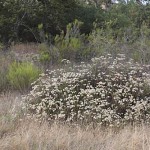 Flat-topped buckwheat (Eriogonum fasciculatum) a native plant.
Flat-topped buckwheat (Eriogonum fasciculatum) a native plant.
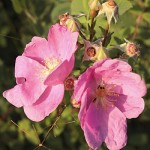 Wild rose (Rosa californica) a native.
Wild rose (Rosa californica) a native.
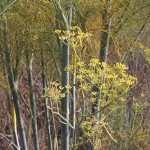 Fennel (Foeniculum vulgare) an exotic, invasive species. This is the culinary plant from the Mediterranean that has escaped into the wilds.
Fennel (Foeniculum vulgare) an exotic, invasive species. This is the culinary plant from the Mediterranean that has escaped into the wilds.
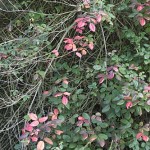 Poison oak (Toxicodendron diversilobum) a native–one of the few plants that turns blazing red in the fall. Even now, it’s showing some of that red color.
Poison oak (Toxicodendron diversilobum) a native–one of the few plants that turns blazing red in the fall. Even now, it’s showing some of that red color.
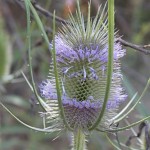 Thistle in bloom. I’m not sure if this is native or not, but it’s not the hyper-nasty Russian thistle (the dried flowers of which are shown in the large photo above). [Correction/edit August 1: This is actually a teasel, not a thistle. Like the escaped fennel above, this too is a renegade exotic species. Pretty, though…]
Thistle in bloom. I’m not sure if this is native or not, but it’s not the hyper-nasty Russian thistle (the dried flowers of which are shown in the large photo above). [Correction/edit August 1: This is actually a teasel, not a thistle. Like the escaped fennel above, this too is a renegade exotic species. Pretty, though…]
It’s a condition of our consumer culture and times to want what we don’t have. Living in San Diego, most of the plant materials that people expect to find in their home gardens fall outside of the category of what occurs naturally or is well-suited to the area.
It’s always instructive to visit the natural preserves to see plants–even the nasty invasives–that are supremely well-designed to live in this climate. Some of the plants in these parks would do extremely well in gardens. But it’s hard letting go of plants that many of us associate with places we’ve lived in and even people we’ve known.
My own yard has several areas that I consider my guilty pleasure zones. I have pieces of a bromeliad and a kahili ginger that I was given in the 1970s, as well as the green rose from that I dug up from the house where I grew up in the Los Angeles area. And I’m a natural born collector who has a hard time saying no to interesting plants. These plants all require some water and tending beyond what nature brings.
But they’re counterbalanced by garden areas planted with drought-tolerant species, local and introduced, that receive almost no water and attention over the summer. As time goes on, I’ll be expanding those areas. Don’t expect me any time soon, however, to plant poison oak, as pretty and hardy as the plant is. I have my limits as to how much true nature I want in my garden…

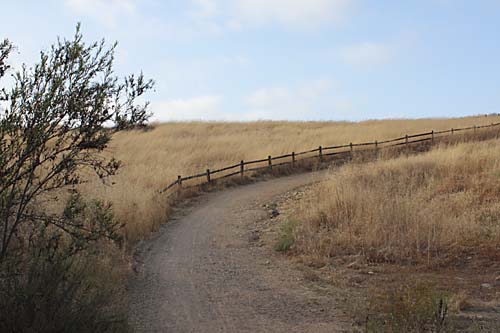
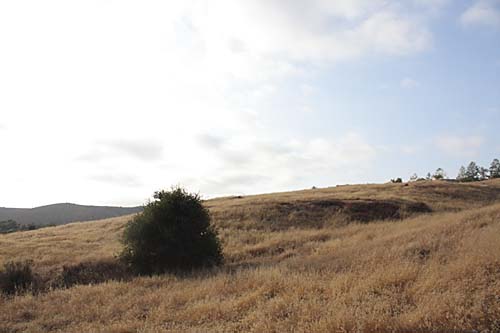
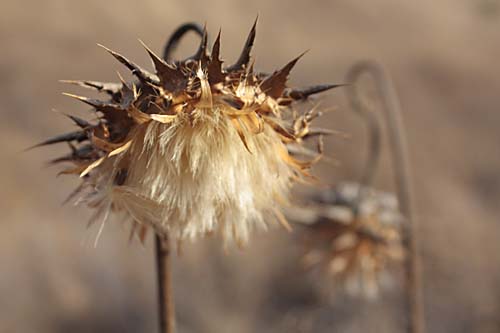
No one will fault you for not welcoming poison oak!! What a beautiful thistle that is…it looks so unlike what I’ve been calling that in my garden that I wonder what it is really growing out there on the fence.
Love the idea of planting more native plants, for beauty that doesn’t require squandering of water resources…but I know I’ll always have a few guilty pleasures on hand for that extra joy.
How was your earthquake experience today?
Thanks for your concern about the quake–Not much here in San Diego, I barely felt it. I have a sister three miles from the epicenter and a niece right at the epicenter–Haven’t heard from either but am assuming they’re fine. Sounds like my family’s quake-prone–John has an aunt in Northridge where the last substantial Southern California quake was. They definitely had more problems than anyone in yesterday’s quake.
I looove your picture at the top, with the curving path and wooden fence. It looks very peaceful. Ironically this is the first year in long time where we have more “not brown” stuff in the garden. This I attribute to limited spot watering (tricking water into a small berm around each plant) and my favorite new mulch, Starbucks coffee grounds. So far, I haven’t had a plant that didn’t perk up with a little!
Thanks, Sheila!
I’ve always secretly wondered if plants enjoyed the caffeine in the coffee grounds. We dump out the grounds from the morning coffee into the garden, but that’s nothing like Starbucks quantities…